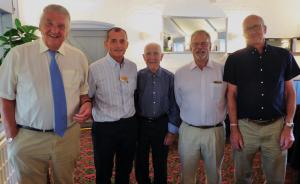April Speaker Meeting
Tue, Apr 18th 2017 at 7:00 pm - 9:30 pm
With David Homewood on ~ Talking Machines
BEXHILL ROTARY IN A SPIN … IS THIS A RECORD?!
The speaker at our meeting on 18th April, was Dave Homewood who spoke on the origins of talking machines along with early and not so early versions from his collection of nearly 100 examples.
Dave Homewood waxed lyrical about his passion for talking machines which began at the tender age of 5 when he was presented with his first example by an aunt. Dave, born and bred in Eastbourne where he still lives, said this one act stirred his interest and the collecting bug took hold.
He then went on to explain that in 1887 Thomas Edison invented the very first talking machine/phonograph although he wasn’t convinced it had any future so he concentrated instead on developing the light bulb.Fortunately, the Columbia Gramophone Company took it on and made a huge success of the phonograph.This annoyed Edison so much that other people were making money from his invention that he came up with own cylinder playing machine in 1903.Much to the surprise of the assembled Rotarians, Dave played the original recording of Florrie Forde singing ‘Down At The Old Bull & Bush’ on a replica 1903 cylinder machine that he himself had built.
Back in the late 1800’s, Dave said, a German by the name of Mr. Berliner concluded the cylinder didn’t have a future and decided it would be better recording on to a flat disc so he got a factory in Maiden Lane in London (next to Rules Restaurant which still exists to this day) to produce his gramophone which proved so successful that it replaced the outdated cylinder. To show that the recording techniques and quality had improved,
Dave then played another recording on a 1910 gramophone and explained at the same time that the early 20th century volume control was by sticking a sock in the speaker, hence the origins of the expression ‘Stick a sock in it!’Dave’s next demonstration was a 1925 recording done with the latest recording equipment of the time of Jack Hilton’s Orchestra playing ‘Paddlin’ Madelin’ Back Home’.More later recordings including the 1939 example of Artie Shaw playing ‘Begin The Beguine’ followed from Dave showing how much progress was being made with sound quality right through to the late 1950’s when it was the demise of the wind-up gramophone and old style 78 rpm recordings, these were replaced by electric gramophones playing 45 and 33 rpm.
During his talk, Dave mentioned the history of a painting by Mark Barraud of his dog, Nipper, looking at a phonograph which he entitled ‘Dog looking at and listening to a phonograph’. He registered the painting in February 1899.However, after several unsuccessful attempts at selling the painting, he eventually sold it to the Columbia Recording Company in Maiden Lane, London for the princely sum of £100 who then renamed it ‘His Master’s Voice’ and used it on their advertising literature.It eventually found its way on to their records and was registered as a trademark in 1910 making it the longest running company trademark still in existence and featured in the Guinness Book of Records.
Anthony Thomas wound things up with a vote of thanks.
'What We Do' Main Pages:
This is a summary of the Club's activities for the last quarter. The document is in PDF format so make sure you have Adobe Acrobat Reader installed to enjoy it.
moreClub Management.
moreRaises Money for our Community and Rotary Charities
more
Our club web site now provides a full history of our club but the following gives an overview of previous years.
more






